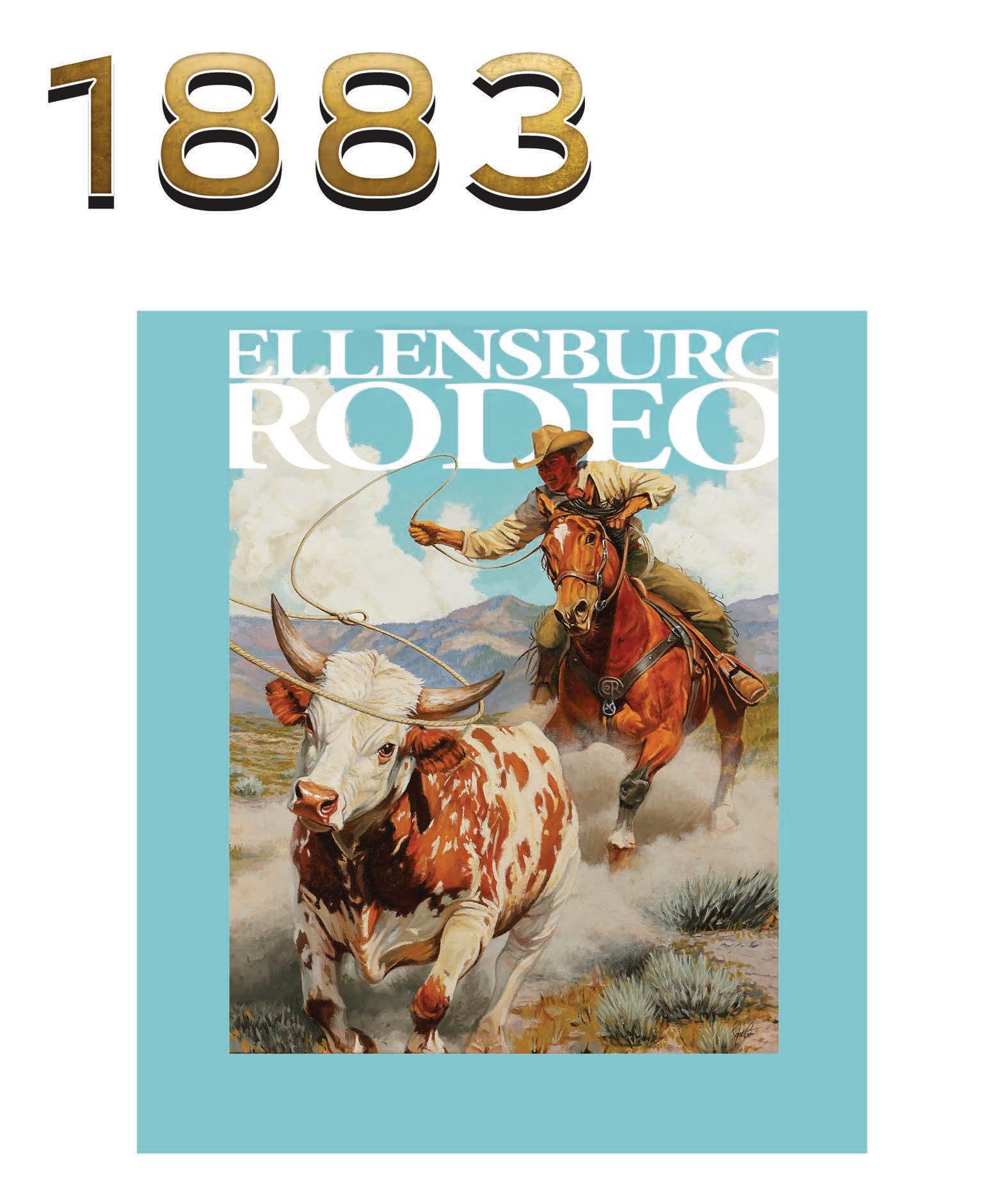

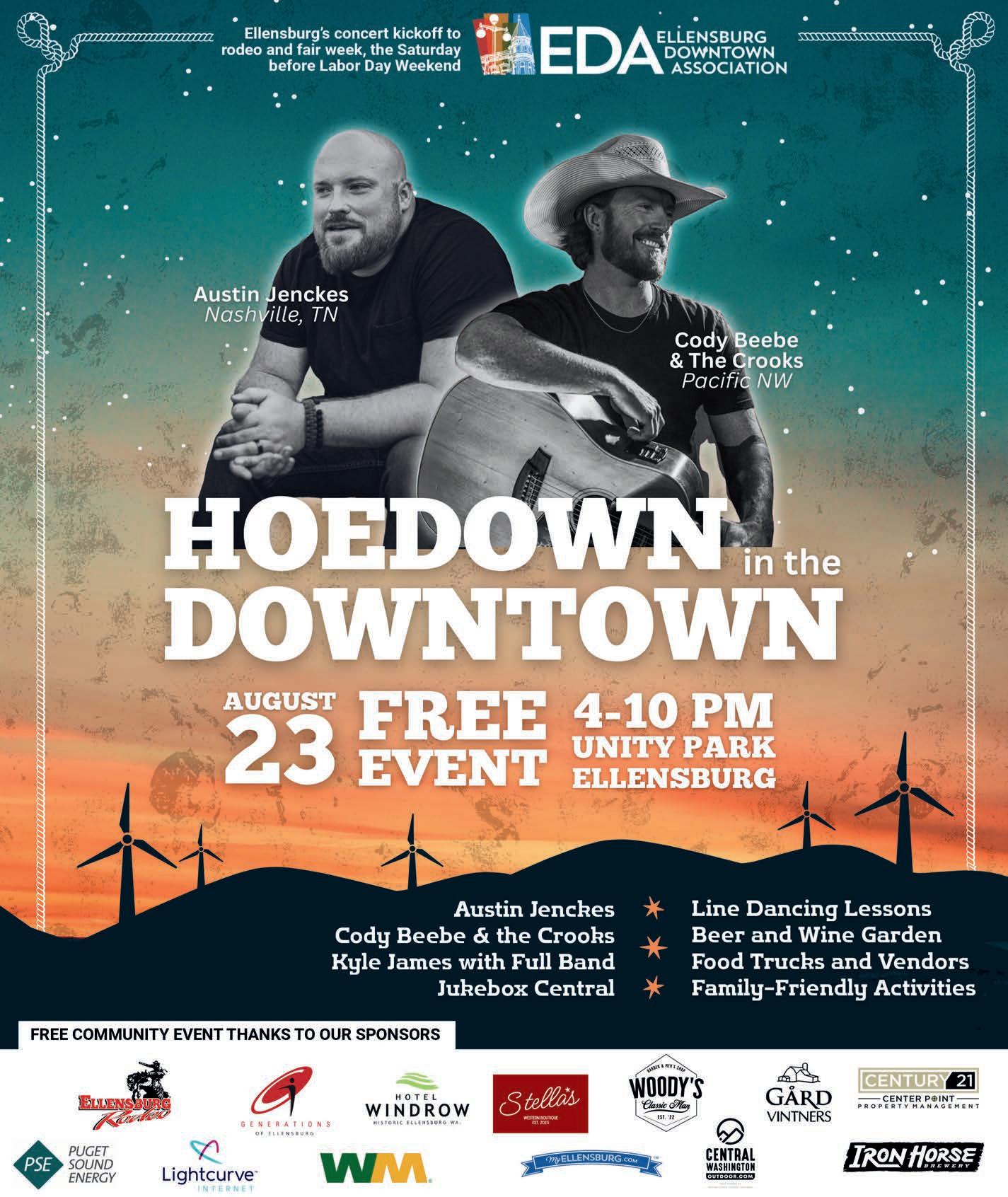
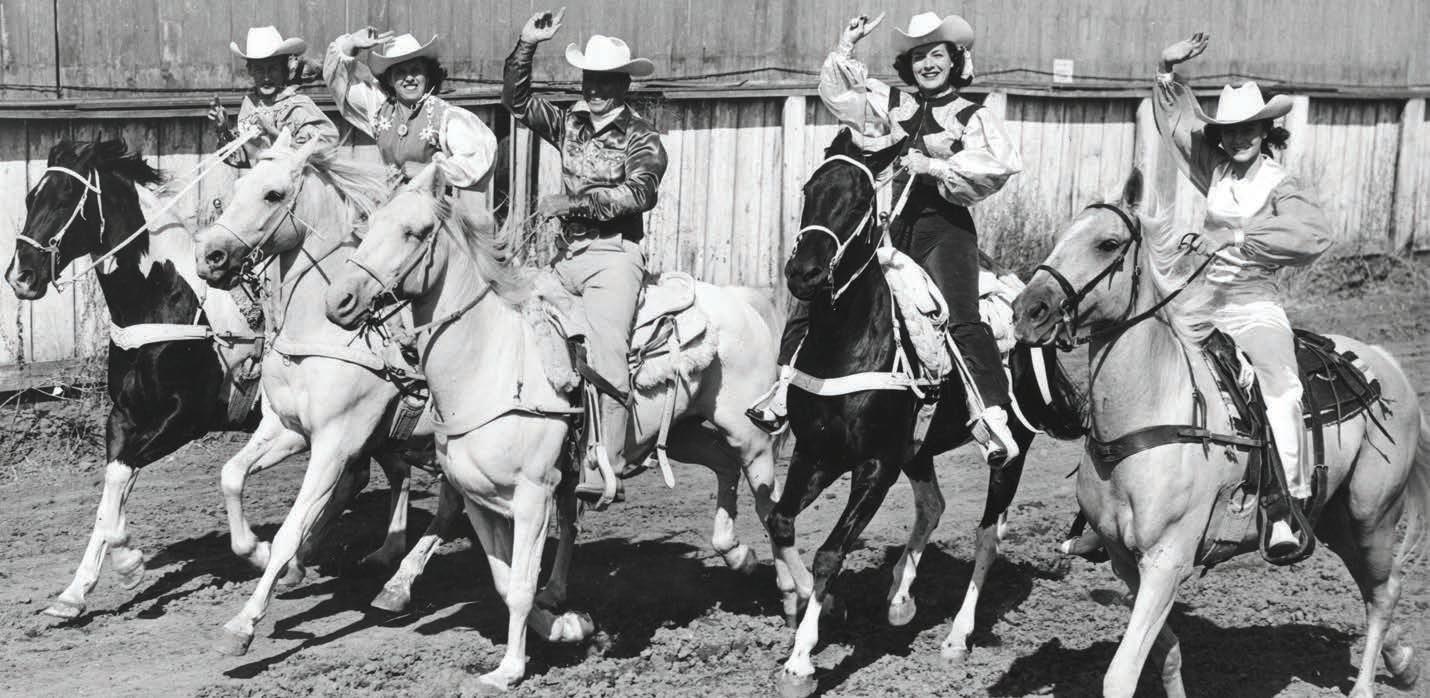





The 2025 Ellensburg Rodeo poster is by artist Jared Carter. Born and raised in the Kittitas Valley, Carter started dabbling in art as a child. His mother encouraged his passion by providing a wide variety of mediums for him to practice with. Eventually Carter focused his main diciplines to tattooing and oil painting. Carter said this piece was inspired by Frederick Remington, a master of old western paintings. Legend of the Lariat is for sale through the Ellensburg Rodeo Office and online at ellensburgrodeo.com.

Kittitas County has always been rich in talent. We’ve celebrated that creativity across stages, galleries and open fields. And the best part? We’re far from finished.
Every Labor Day weekend a different kind of artistry takes center stage: the grit, grace and athleticism of the Ellensburg Rodeo. As one of the oldest and largest rodeos in the county, this event honors generations of tradition with unscripted and raw performances.
The Ellensburg Rodeo Hall of Fame shares:
“The men and women who founded the Ellensburg Rodeo in 1923 were ranchers, farmers, Indians and community-minded citizens in a group effort of huge proportions. They were motivated not only by a desire to celebrate a vanishing frontier way of life, but also by a desire to promote the community and generate commerce.”
We’re proud to partner with the Ellensburg Rodeo Hall of Fame to spotlight some of the incredible stories they’ve preserved, both in their museum and online. Looking to experience rodeo before the rodeo? The Ellensburg Rodeo Hall of Fame museum will be open during Rodeo Weekend — bring your friends

and family to experience this rich showcase of art, culture and Western history. You won’t be disappointed. If you’ve enjoyed the stories we’ve shared today, you can read more by visiting: www. ellensburgrodeohalloffame.org.
We’re downright tickled by your enthusiasm for 1883 Kittitas County Magazine. Every month, with a fresh batch of 1883, your smiles and hollers make it feel like Christmas morning — only with more cowboy hats and a little less wrapping paper.
It warms our hearts to know you’re not only reading the stories, but tucking them away for safekeeping — whether it’s on the family bookshelf or squirreled away in your kids’ time capsules. That kind of connection means the world to us. Thank you friends, we are feeling your love.
We promise to keep bringing stories worth flipping through — you just keep on reading.

Happy trails to you, until we meet again.
Robyn Smith, Publisher
Andrea Paris, Editor/Designer
Contact us at editor1883kittitascounty@gmail.com
1883 Kittitas County is a publication of Spark Pug Productions. It is a monthly publication. Free editions may be found in numerous sites throughout Kittitas County. Original stories, story ideas, photographs, illustrations, art or poems about Kittitas County are welcome. Send them to editor1883kittitascounty@gmail.com. 1883 Kittitas County is politically neutral and will not publish any hate speech against any person or entity. 1883 Kittitas County reserves the right to publish or not publish any submitted items, edit all materials for content and check for accuracy.
The Ellensburg Rodeo is steeped in traditions. The men and women who founded the Ellensburg Rodeo in 1923 were ranchers, farmers, Indians and community-minded citizens working in a group effort of huge proportions. They were motivated not only by a desire to celebrate a vanishing frontier way of life, but also by a desire to promote their community and generate commerce. From their efforts, Washington State’s world famous Ellensburg Rodeo was born.
Rodeo is a relatively young sport. It is based on contests from cattle roundups, Mexican fiestas (called encharreada), Wild West Shows, and Indian “pow wows.” Rodeos emerged during the last quarter of the 19th century just as the “Cattle Kingdom” had reached its summit and the West was a more settled region. Some of the first rodeos were impromptu amateur affairs held in conjunction with the annual roundups in cattle country. Having gathered together their herds for branding and sorting, cowboys often used the occasion to exhibit their skills in riding, roping and bulldogging. Competitions sprung up naturally among top hands as their fellow cowboys looked on.
But when non cowboy spectators began to appear on the scene, these simple ranch rodeos began to make the transition that would eventually take them into town and into the world of modern rodeo. The newly emerging townsmen of the post frontier West possessed a huge appetite for nostalgic re-creations of the “Wild West” in dime novels and in the rodeo arena. During the late 19th and early 20th centuries, Westerners flocked by the tens of thousands to enjoy the new sport of rodeo.
Ellensburg lies in the heart of a thriving central Washington cattle region. Thousands of cattle and horses grazed the rich meadows and semi-arid plains of the early Kittitas Valley. The roundup competitions that characterized cattle country were commonplace among the Kittitas cowboys. By the early 1920s, Kittitas Valley cowboys had taken the process one step beyond the strictly amateur category. Several ranches in the valley were staging contests, or as the locals called them, “Sunday Rodeos.”
Clovis Chartrand, a long time valley resident, remembered one of these Sunday rodeos at the “upper river bridge, which is where the Thorp Bridge is now, west of Ellensburg.” Ben Ferguson, a Kittitas Valley cowhand and rodeo competitor described his family’s promotion of an important Sunday rodeo:
“[We] had all them horses and, my brother and a couple of friends put on a rodeo…. My brother, he just wanted to have some fun. Just got a neighbor boy or two up here, went out and rounded them [cattle and horses] up. They got a wagon load of poles and made the corral and made the arena [and] chutes.” During the early 1920s the Fergusons were staging rodeos “every other Sun-
day.” It was not unusual for 100 to 300 spectators to attend.
The economic potential of all this activity did not go unnoticed. Ferguson remembered that several townspeople saw “that we was having a big time” and began to discuss the possibility of staging an annual rodeo in the Ellensburg city limits (the Kittitas County Fair had already sponsored rodeo exhibition events). Sometime around 1922 a group evidently came to ask the Ferguson brothers to assist in the staging of the first annual Ellensburg Rodeo:
“They [the townsmen] come out and got us to go in there [to Ellensburg] and furnish the horses.”
Local ranchers and cowboys allied with three other groups— downtown businessmen, the Fair Board and Indians—to create the Ellensburg Rodeo.
Local businessmen and professionals were quick to jump on the rodeo bandwagon.
A rodeo would draw visitors to Ellensburg, generating tourist revenue and promoting the community’s business prospects and prestige in the region.

The first Ellensburg Rodeo program.
— Photo courtesy of the Ellensburg Rodeo Hall of Fame
The Kittitas County Fair Board, which included townspeople and farmers alike, proposed the inclusion of a rodeo in the venue of the Kittitas County Fair, held annually in the early fall. The Fair had already sponsored intermittent rodeo events. An annual rodeo, they reasoned, would enhance the quality of the Fair and increase attendance.
Local Indians formed the vital fourth group of the rodeo coalition. The Kittitas Band of the Yakama Nation had, for hundreds of years, taken part in an annual fall pilgrimage to what Columbia Plateau Indians called their Kittitas “Meeting Grounds.” Kittitas and Yakama Indians (including the SoHappy and Nason families) were very supportive of an event that would continue this Meeting Ground tradition. They saw a fall rodeo as an opportunity to

continue their dancing and horse racing traditions in the modern age.
The rodeo boosters immediately faced a huge obstacle: they needed money to buy land for the grounds, construct an arena and stage the proposed three day event. At the urging of newspaper editor Clifford Kaynor, businessman Clarence Fitterer and several others, the Kittitas County Commissioners started the ball rolling on April 1, 1923, budgeting $10,000 for the purchase of 18 acres adjacent to the fairgrounds in northeast Ellensburg. State Representative Phil Adams garnered some state government support. Since the land cost $6,450, the balance would be used to construct the arena and bleachers. Still, this was not nearly enough money to pay for the lumber, tools, horse teams and huge labor force necessary to construct the grounds. In a bold move, the Fair Board called upon valley residents to donate materials and labor for the construction of the rodeo grounds, and they set Thursday, June 14, as the date of a “field day” to build the new arena.
Ellensburg’s field day was actually a series of work days held in June of 1923. However, the work reached a crescendo on June 14 when more than 500 valley men and women turned out to work on the grounds.
The Ellensburg Evening Record served as the voice of the field day organizers. On Monday, June 11, the Record previewed the official plan: “Every Man Urged to Report to his Strawboss at 7:30 Thursday Morning. All Superintendents and Foremen Have Been Over Job and Know Work to be Done Men Unassigned Should Bring Picks and Shovels.”
In a Tuesday article entitled “Women of the Valley and Town Respond,” the Record discussed the “Feed” local women planned for Thursday noon. Local merchants donated coffee, “weenies on buns,” ice cream, and other foodstuffs that women volunteers prepared
and served on the grounds building site. Another Tuesday article stated optimistically that “Movie Men May Come to Field Day” and noted that one movie maker wanted to film a “good slow action comedy of some banker or lawyer in the pick and shovel brigade.”
Five hundred men with more than 200 horses assembled on Thursday and set to work. They graded a road, a racetrack and the grounds and rerouted Wilson Creek around the site. They finished building corrals, fences, three bridges and a grandstand; they plumbed new water mains, dug ditches and pruned trees. Their accomplishments were remarkable, and the Record’s headlines shouted, “COMMUNITY EFFORT IS SUCCESSFUL.”

Kittitas County Fair and Rodeo Board members, townspeople, ranchers, farmers and Indians spent the remainder of the summer planning the first Ellensburg Rodeo. Dr. H. F. Pfenning served as “superintendent” for a three day show that was slated for Sept. 13-15. Pfenning and his committee began by inviting the entire Yakama Indian Nation to attend and participate in the rodeo. They scheduled 18 major events and advertised the rodeo as the “greatest Wildest Roundup in the State.” By early September, Kittitas Valley residents waited anxiously to see if the upcoming rodeo would be as successful as its creators hoped.
Despite a few problems caused by the large crowds, most in attendance reportedly “yelled and cheered and thoroughly enjoyed Ellensburg’s first real rodeo.”
Local cowboy Frank Woods was named “Champion Buckaroo of the Roundup” at the conclusion of Saturday’s show. The Record applauded Dr. Pfenning and the Fair and Rodeo boards and “the hard work of the men responsible for its success.” On Sunday, the stock was driven home, cowboys packed up their gear, the Indians rode back to the Yakama Reservation and local businessmen counted their generous receipts. Every-
one looked forward to the next year’s rodeo.
In retrospect, it is interesting to think about the motivations of the Ellensburg Rodeo’s founders. It is true to say that Ellensburgers staged a rodeo as a celebration of their frontier heritage. Cowboy competitors utilized actual ranch roundup skills in the varied events and Yakama and Kittitas Indian participants furnished a vital link to the frontier past through their horse racing and traditional dances.
Yet the Ellensburg Rodeo was far more polished and professional than a ranch rodeo or even a “Sunday rodeo.” So, the desire to stage a rodeo can also be attributed to nostalgia. This was a nostalgia modern townsmen and valley residents felt for a pioneer way of life that was vanishing in their world of automobiles, airplanes moving picture shows and radio broadcasts.
In a very important way, the people of the Kittitas Valley relied upon their frontier heritage to create their rodeo. Volunteerism — the community spirit of the pioneer days — provided the base upon which the Ellensburg Rodeo was built. Without volunteer community workers, the first bucking bronc may have never exploded out of the chutes into Ellensburg’s new rodeo arena on the day the Ellensburg Rodeo was born.
— Mike Allen, Ellensburg Rodeo Hall of Fame
The Rodeo Grandmas of Ellensburg – Janis Anderson, Judy Golladay, Peggy Minor Hunt, Lorraine Plass and Chloe Weidenbach – were all Kittitas Valley ranch women when they filmed a series of 1990s television commercials for Washington Mutual Bank of Seattle. The bank was launching a new advertising campaign called “That’s Different” aiming to use regional human interest stories to attract attention. When the idea of an “off-beat” commercial about grandmas and their activities arose, Jim Walker of the McCann Erickson/Seattle Ad Agency who produced the commercials for Washington Mutual, mentioned it to his friend Arley Harrel, a Seattle attorney who grew up in the Kittitas Valley. Harrel suggested the bank use Kittitas Valley ranch women for the commercial and his sister Jan assisted the McCann Erickson Advertising Agency when they arrived in Ellensburg in 1993 to interview 20 grandmothers. After much deliberation and two separate casting calls they chose Anderson, Golladay, Hunt and Plass. Weidenbach, Plass’s daughter, who traveled with ladies from the beginning, became a Rodeo Grandma five years later after Golladay’s passing.
At the heart of the filmed Washington Mutual commercial was the fun-loving notion of older women (the four were aged from 52 to 82) riding the range and “Keeping the Northwest safe for truth, justice and FREE CHECKING”! The bank dubbed the Ellensburg quartet the “Rodeo Grandmas.” Astride their horses and decked out in full western attire, the Rodeo Grandmas defended the traditions of the Old West, keeping “bad bankers” on the run and making sure the “good guys and gals” won the day. The commercial first aired on Jan. 17, 1994, and Northwesterners immediately liked it and talked about it. The commercial caught fire.
In later years, the “Rodeo Grandmas” filmed two follow-up commercials for Washington Mutual. The second was filmed in Kittitas County in Caribou Canyon near the Colockum and the other in Los Angeles, Calif. Meanwhile, after the first commercial and with an Associated Press story written by Aviva L. Brant in the Yakima Bureau and a photo by Molly Morrow that went out on the wire on April 17, 1994, the Grandmas’ phones were ringing, and they were invited to make what turned out to be scores of personal appearances. Accompanied by their friend, manager and photographer Morrow, they became celebrities, known for their western lifestyle and skills at riding horses, performing roping tricks, yodeling, storytelling and working with and roping cattle. Much of the success of Washington Mutual’s campaign was due to choosing four women who were authentic cowgirls. Janis Capezzoli Anderson was born and grew up in a ranching family in Standish, Calif. She and sister Joanne helped their parents with ranch chores — working and branding cattle and also herding sheep and doing agricultural work.
“My dad didn’t have any sons and so my sister and I became the boys of the family,” Janis told journalist Hanoch McCarty. “My dad called me ‘Toughie’ and he taught me how to ride. Horses have always been in my blood.”
Janis Capezzoli married Jerry Anderson (also a roper and Ellensburg Rodeo Hall of Fame inductee) and her daughters Mary Minor and Lori Fishburn attended school here and married local men. Janis has three grandsons, one granddaughter and one great-grandson. In years past, Janis and Jerry assisted her daughter and son-in-law Mary and Brent Minor in working their ranch, and her grandchildren include NFR multifinalist team ropers Brady and Riley Minor. A team roper herself, Anderson has competed and won prize money at roping jackpots including a second place at Cave Creek, Ariz. “Rodeo is very dear to me and I have wonderful memories of riding in the Grand Entry with the Rodeo Grandmas,” she recalls. “I rode with a great sense of honor and pride.”
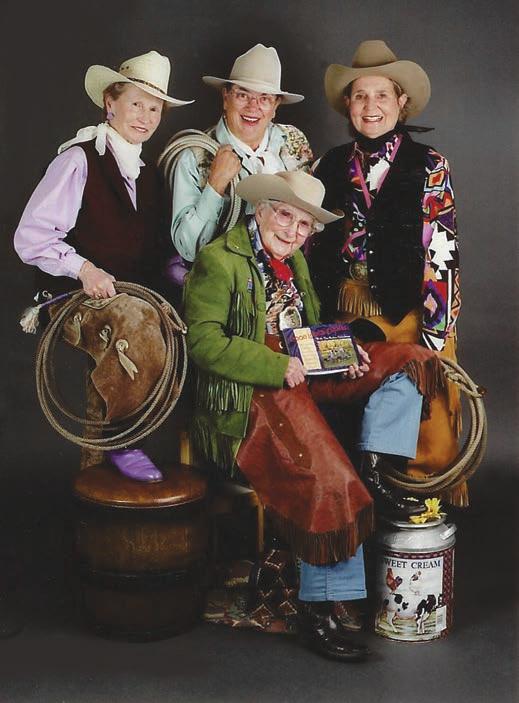
Peggy Minor Hunt came to Ellensburg from the small town of Thoeny, Mont. with her family at the age of 4, and grew up on her parents’ ranch on Wilson Creek, ranching, riding horses and roping. Peggy (previously inducted to ERHOF as a member of the Minor Family) was a 1947 Ellensburg Rodeo princess. She married Gerald Hunt, and together they worked rodeos in the US and Canada when they were not ranching. Peggy and Hunt raised
four children: Wayne Hunt, Kenneth Hunt, Sheri Hunt Wippel and Kristine Hunt Olson, whose children made Peg a “Rodeo Grandma.”
When she was a young woman, Peg bought a trick riding saddle from famed trick roper Monte Montana (also an ERHOF inductee), and with her horse, Pepper, was in business as a professional trick rider and roper. Peg Hunt’s trick riding included the Hippodrome Stand and the dangerous Cossack Drag (also called the “Death Drag”) which involves hooking one’s right foot in the stirrup and laying out over the left side of the horse with one’s head almost to the ground. To trick riding, she also added trick roping and would perform the “flat loop, Wedding Ring, Texas Skip and jump through” which involved standing on a horse, twirling a rope, and jumping through the loop. There is a picture in the Ellensburg Public Library’s archives showing her spinning four loops at once: one with each arm, one from her raised right foot, and one from her teeth. It was Peg’s ranch and rodeo background and her rope skills that lassoed her position as a Rodeo Grandma in 1993.
“The sky is my ceiling and the ground is my carpet,” cowgirl Judy Golladay once reflected. She was born Judy Hastings in Everett and grew up on her grandparents’ western Washington farm. Judy first learned to ride as a child on a borrowed donkey and she bought her first horse with money she earned picking strawberries. Soon she was racing barrels and pole-bending with western Washington riding clubs and in playdays.
In 1968, Judy moved east to Colockum Springs Ranch, in the northeast corner of the Kittitas Valley. She bred and raised horses and trained cattle dogs (later a crowd favorite at the Grandmas’ appearances). In 1979, she married Max Golladay, a former Kittitas County Commissioner. Judy and Max had a foster daughter, Peggy Mead of Lake Stevens and two grandchildren.
the same affliction. The 1998 Labor Day performance of the Ellensburg Rodeo was dedicated to the Rodeo Grandmas.
At 82 in 1994, Lorraine Plass was the oldest of Rodeo Grandmas and became their story teller. A native Nebraskan and Coloradan, Plass had a long history of riding, roping and chasing down cows. She met her husband George at the Denver National Western Stock Show in 1928, and they had two daughters, Betty Swisher and Chloe Weidenbach. Daughter Chloe became a talented roper and queen of the Adams County, Colorado Rodeo. Chloe married rancher Eldon Weidenbach and settled in the Kittitas Valley
plaid shirt and red neckerchief, faded jeans, and a felt “flat top” weathered cowboy hat, she looked like the grandma lovers of the West wish they had.
As noted, the Rodeo Grandmas enjoyed popularity that spanned far beyond their Washington Mutual Bank commercials. For nearly a decade, they traveled across the Pacific Northwest and United States. They were special guests at the grand opening of the National Cowgirl Hall of Fame in Fort Worth, Texas. The Rodeo Grandmas appeared at conferences on aging with Senator Orrin Hatch and his wife Elaine, fundraisers, fairs, rodeos, festivals, parades, schools, commercial promotions, retirement homes and hospitals on behalf of the bank as well as their individual group. They appeared in the Ellensburg Rodeo. Accompanied by Morrow, the Grandmas were also featured on radio broadcasts and regional and national television programs, including the “CBS News This Morning,” “Entertainment Tonight,” the “Rosie O‘Donnell Show” and NBC’s “Today” show. They produced a line of “Rodeo Grandma” merchandise and even wrote a cookbook.
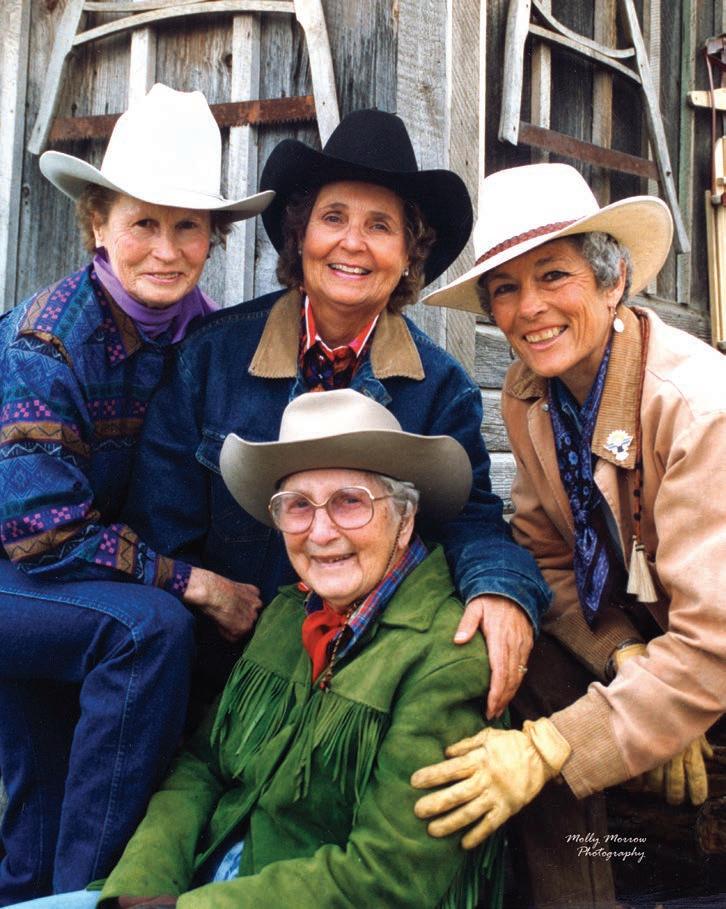
Judy had been hiring out as a cowhand, riding for the famed Schnebly Bar Balloon Ranch (also ERHOF inductees) and other area ranchers. She could be seen moving cattle with her three well trained cow dogs, Tar, Quill and Jude. She formed the Sage Scrappers, her crew of veteran lady cowhands who worked and rounded up cattle Peg Hunt said Judy “just loved to ride up there on the high range. She said she was near God up there.” And former Ellensburg Rodeo Board member Brad Fitterer noted Judy was “a really talented horsewoman who understood cattle and always had a smile for people.”
Golladay died of breast cancer on Aug. 16, 1998 at age 57. She fought the disease to the end, evoking the spirit of a saying she loved—“Get western and don’t weaken.” Her wish was to beat the disease and then help and give inspiration to others who were suffering from
in 1972. Chloe and Eldon had four children, Gwen Green, Wade Weidenbach, Barbara Sheldon and Chris Weidenbach along with 11 grandchildren and two great-grandchildren. Lorraine and George joined them in the Kittitas Valley in 1975 and helped out on their 800 acre ranch. At the time the Rodeo Grandmas gained popularity, Lorraine had nine grandchildren and 19 great-grandchildren.
Morrow said that Plass was “funnier than heck,” and Lorraine herself said that at the Grandmas’ performances, “Judy takes her cow dogs, Peggy puts on her rope tricks, Janis ropes, and I just open by big mouth.” This was her way of saying that one of her skills was yodeling. In her green fringed-leather jacket,
The Rodeo Grandmas’ performances varied in length and components, depending on the audience and the venue. Morrow would begin by showing short film clips of the bank commercials and television interviews, and then introduce the Grandmas. The women talked with the audience about their cowgirl lives and answered questions. Each possessed skills that became part of the performance. Peg was a trick roper, while Janis and Judy expertly lassoed a “roping dummy” astride “Handsome Jack”, a life-sized paint horse with a calf on a track they brought with them. Lorraine turned out to be a real entertainer, regaling the audiences with western tales and teaching them how to yodel.
Golladay’s 1998 death was met with extreme sadness and she was mourned throughout cattle country. Golladay’s empty saddle was eventually filled by Lorraine’s daughter Chloe Weidenbach. A seasoned cowgirl in her own right, Chloe was already a member of the grandma entourage, accompanying her mother and wrangling the Rodeo Grandmas’ horses and stock. Chloe’s role in the performances featured her horsemanship and roping skills.
Around 2004, the Grandmas began to reduce the number of their appearances and return to their daily lives. Lorraine Plass passed away at 94 on Oct. 20, 2006, and Peggy Minor Hunt passed away at 86 on May 25, 2014, leaving Janis Anderson and Chloe Weidenbach as the remaining Rodeo Grandmas.
Since the publication of this story all of the orginal Rodeo Grandmas have passed. Chole Widenbach is the lone surviving member who recently celebrated her 90th birthday.
— From the Ellensburg Rodeo Hall of Fame archives
War Paint earned his reputation as an outstanding rodeo athlete
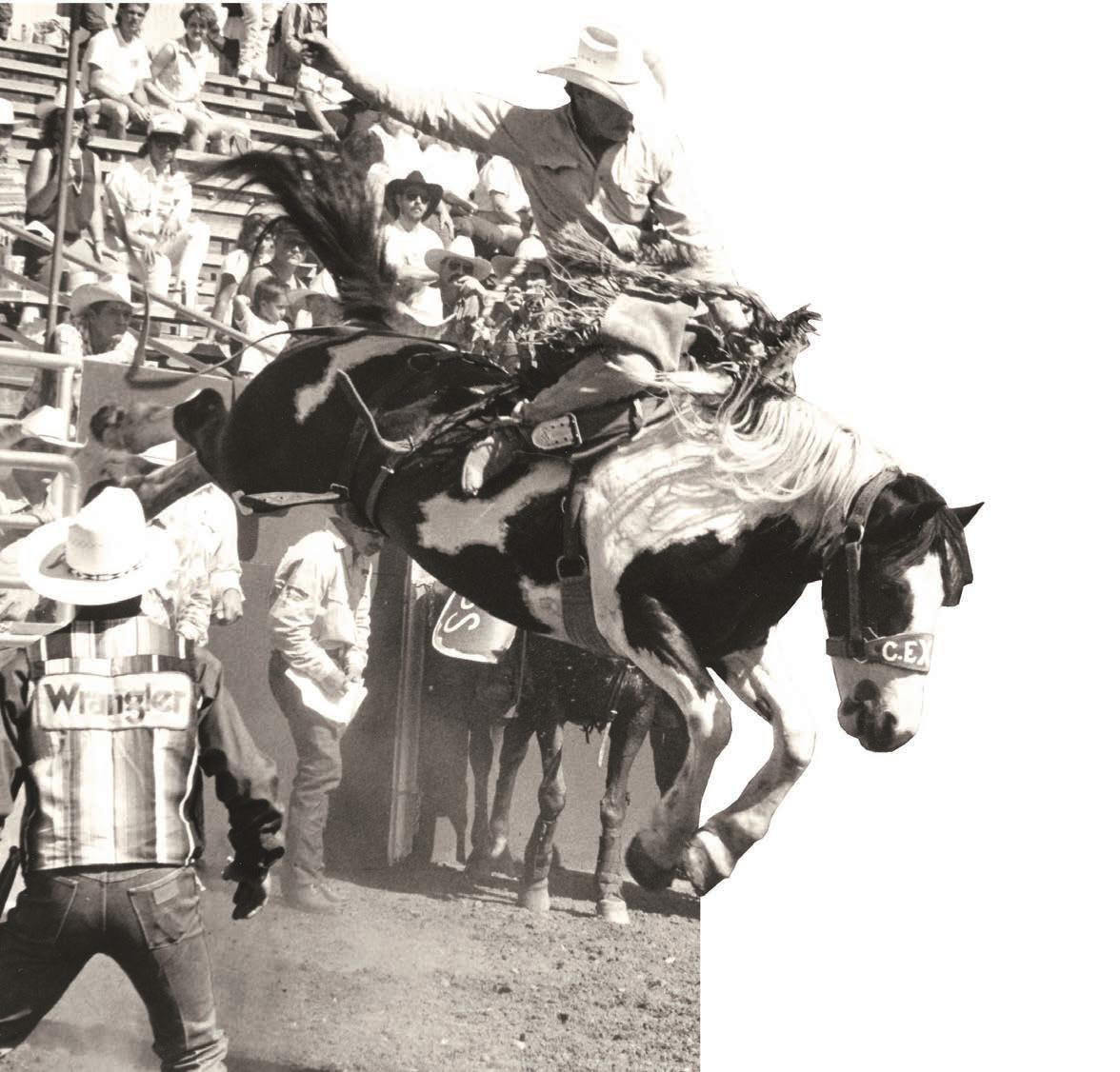
ar Paint, the famed Christensen Brothers pinto bucking bronc, was a 2001 Inductee to the Ellensburg Rodeo Hall of Fame. War Paint was born in the late 1940s (no one is sure of the exact date) on Oregon’s Klammath Indian Reservation. Orie Summers sold him to Hank and Bob Christensen, Sr. (ERHOF ’99) at approximately 3 years of age. They started the 1,400-pound gelding out as a bareback horse but moved him to saddles where, in the 1950s, he achieved
In the year 1958, for example, War Paint appeared 28 times, bucking off 25 of the riders. One rodeo historian wrote that many a bronc rider’s comment after “seeing the paint go was –‘That spotted horse is the one I want’ – but generally, after a seat on him, they’d be out there checking their eyesight the next time they got a chance to see him go!”
Denny Jones, an Oregon State Representative who worked the Pendleton Roundup as a pick-up man, remembered War Paint as a bronc in the same league as the immortal pre-World War II-era greats Midnight and Five Minutes to Midnight.
“War Paint was still buckin’ when he was 20-years-old,” Jones recalled.
During a 15-year career, War Paint traveled more than 540,000 miles and received fan mail from all over the world. In 1956, he became the first horse to win the silver mounted halter of “Bucking Horse of the Year.” He retained the Bucking
War Paint was always a crowd pleaser in the Ellensburg Rodeo arena where champion Deb Copenhaver (ERHOF ’99) noted, “That pinto is a sure day-money horse. He just bucks hard and keeps trying.”
Bobby and Hank Christensen retired War Paint at the 1964 Emerald Empire Roundup in their hometown of Eugene, Ore. Today, War Paint’s body is displayed in the Pendleton Roundup Hall of Fame, where he is an honored animal
— Story and photo from the Ellensburg Rodeo Hall of Fame



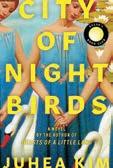
“City of Night Birds” by Juhea Kim
Author Juhea Kim has crafted a compelling work about a prima ballerina, Natalia Leonova, who returned to St. Petersburg, Russia, following an accident that derailed her promising career. After turning to pills and alcohol to numb the pain of her past, Leonova must decide whether to follow her heart or pursue a path that could return her to the stage but threaten her happiness. The novel, Kim’s second, is an insightful look into the world of the Russian ballet, with its often-treacherous politics, unbridled ambitions, and potential for artistic triumphs.

“ Life Form” by Jenny Slate Actor, comedian, and New York Times bestselling author Jenny Slate, who co-created the delightful Marcel the Shell (with Shoes On), has written what her publisher, Hachette Books, has described as a “wild, soulful, hilarious collection of genrebending essays depicting the journey into motherhood as you’ve never seen it before.” Telling the story in five phases—Single, True Love, Pregnancy, Baby, and Ongoing—Slate recounts her odyssey in the form of humorous letters to her doctor and others.
“When the World Tips Over” by Jandy Nelson (Ages 14 to 17)
Set in Northern California’s Wine Country, this book by Jandy Nelson,

author of “The Sky is Everywhere,” recounts the story of the three Fall siblings, ranging in age from 12 to 19, who are trying to hold their family together after their father mysteriously disappeared years ago. A strange rainbowhaired girl appears, who seems to hold importance to each of the Falls. But before they can figure her out, catastrophe strikes, which leaves the siblings even more desperate to be whole. This is an intricate tale about a family’s complicated past and present, and their hope of navigating a brighter future.
“ Bompa’s Insect Expedition” by David Suzuki with Tanya Lloyd Kyi; Illustrated by Qin Leng (Ages 4 to 8)

This beautifullyillustrated picture book tells the story of twins Nakina and Kaoru, guided by their grandfather, Bompa, as they go on a nature expedition in their own backyard. They learn all about such things as frogs eggs in a pond and a wide variety of bugs. Authors David Suzuki and Tanya Lloyd Kyi provide interesting facts about insects, information on how children can help bugs to thrive, and explain how essential bugs are to our world.
• The Friends of the Ellensburg Public Library sponsor a used book sale on the first and third Saturdays of every month from 10:30 a.m. to 1:30 p.m. in the Hal Holmes Centers downstairs. Check it out!
• The Ellensburg Public Library is open Monday through Friday, 10 a.m. to 6 p.m., Saturdays, 10 a.m. to 2 p.m.
— The Reference Desk: What’s New at the Ellensburg Library is written by Richard Moreno.

Grandma Lorraine made this just to get out of the kitchen.
1 lb. hamburger
2 medium potatoes
1 can green beans, liquid included
Put all ingredients into a pan or skillet and add onion and garlic with salt and pepper. Cook at medium heat until meat and potatoes are done.
NO EGG CAKE
1 C sugar
1 1/2 C flour
1 t baking soda
1/2 t salt
1/4 C Cocoa
1/3 C vegetable oil
1T vinegar
1 t vanilla
1 C cold water
Mix together. Pour into a greased and floured pan. Bake half and hour at 350


DREAM BARS
Crust:
1/2 C butter
1/2 C Brown sugar
1 C flour
Topping
1C brown sugar
2 eggs
2T flour
1/4 t salt
1/2t baking powder
1/2 t vanilla
1 1/2 C coconut
1 C nuts
Cream butter, sugar and flour. Place the mixture into an 8 x 12 pan and bake 10 minutes at 350 degrees. Mix topping ingredients and spread over crust. Bake 20 minutes at 350 degrees.
From its 1923 birth onward, the Ellensburg Rodeo has featured a royal court consisting of an Ellensburg rodeo queen and princesses. This is a tradition handed down from the earliest (late 19th century) North American rodeos where cowgirl competitors were honored with the titles of rodeo queen and princess.
Throughout Ellensburg Rodeo history, the Rodeo Board and a select committee annually have chosen a royal court. The queen of the Ellensburg Rodeo is a local cowgirl, as is the princess. Until recently, there was a King County princess; in years past princesses represented various northwest communities, from Spokane to Wenatchee to Tacoma. The queen and princess are chosen on the basis of horseback riding skills, oratory, appearance and fashion sense and poise.
The Ellensburg Rodeo queen and her princess serve as ambassadors and representatives of the rodeo. Throughout the year they travel around the Pacific Northwest riding their horses in neighboring rodeo parades and appearing at a variety of events. During August and September they are booked daily at myriad venues — charity events, social gatherings, newspaper, radio and television interviews — preceding and during the Ellensburg Rodeo. At each Ellensburg Rodeo performance the rodeo royalty demonstrate their horse-riding skills during high speed entrances into and around the rodeo arena.
Hall of Fame Board Members Rochelle Bierek and Julie Virden are both former Ellensburg Rodeo Princesses.
Bierek recalls, “Historically, the royal court provides the glitz and glamour of the rodeo, the beauty to go with the beasts. Being on court is an amazing experience that helps shape girls into the women they are meant to become. It provides tools necessary to become successful in life: communication skills and poise.”
Virden agreed, stating “It was a tremendous honor to serve as a member of the Royal Court and promote such an outstanding rodeo. The experiences and opportunities I had during that year

helped shape me into the Bierek and Virden reflected and change in the Ellensburg In the 1920s, one of was a girl’s ability to tickets. And back Rodeo Board the court with consultation.
“Today, the in speech, riding and and are judged by a with allied rodeo groups and community representation” said Bierek.
Virden noted, “While over time the job of the court has remained relatively the same — to promote the rodeo — the selection process and some of the criteria and activities have changed.”
Both women have fond memories of their time on the Court.
“Being on court makes you a member of a sorority of women who have a common bond,” Bierek concluded.
Since 1923, more than 340 young women have served on the Ellensburg Rodeo Royal Court.
—Ellensburg Rodeo Hall of Fame archives Right: 1931 Queen Ann Horntvedt Photos courtesy of the Ellensburg Rodeo
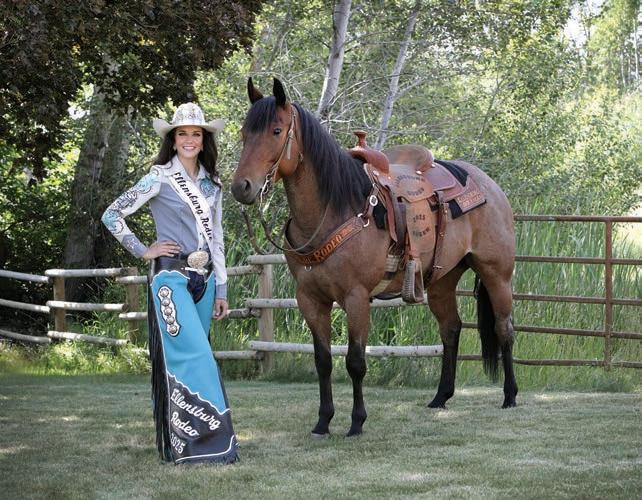

Induction of the Ellensburg Rodeo Wranglerettes into the Ellensburg Rodeo Hall of Fame is a tribute to these cowgirls’ 32 years of service as ambassadors for the Ellensburg Rodeo and the Kittitas Valley. From 1954 to 1986 the all-girl mounted drill team traveled throughout the Pacific Northwest appearing in parades and drill team competitions as well as performing in the Junior Rodeo Night Show, Grand Entryand as a featured act in the Ellensburg Rodeo.
The Wranglerettes made their first appearance at the Ellensburg Rodeo Junior Night Show on Friday, Sept. 3, 1954, and at the Central Washington Fair in Yakima the same year. Those 10 girls were known simply as the “Kittitas Wranglers.” Two years later they became the “Wranglerettes” and two years after that the “Ellensburg Rodeo Wranglerettes.” They were originally coached by Bryce Baker and Lois Clerf with Bonnie Indermuhle as advisor.
The Wranglerettes invited all girls aged 10 to 18 who could ride,
owned a sorrel horse, saddle, boots and a hat to join the group; matching gear, uniforms and transportation were furnished by the club through fund-raisers. Former members recall that while being a Wranglerette was fun, it also took lots of dedication from the girls and their parents. The girls rode to practice twice a week during the summer, made weekend trips to parades and horse shows, staged the Wranglerettes’ annual horse show, performed at the Junior Rodeo and of course rode in the Ellensburg Rodeo Parade, each of the daily Grand Entries and often the Rodeo performance itself. At the same time many of the girls also participated in 4-H clubs and competed successfully as individuals at horse shows and playdays.
Overits 32-year history, the Wranglerettes’ membership ranged from 10 to 48. By 1958 the drill team began to win awards in parades and drill team competitions.
Bryce Baker said, “We have real good drill team material that

has a good chance to be tops on the coast.” Baker was drillmaster, chaperone, horse doctor and rodeo “father” to the girls. He was assisted by Cal Shull. When Baker died in 1961, George Mills volunteered for the drillmaster position. The biggest challenge was teaching the girls precision in drill and horsemanship. The 33 members of the 1960 team won the SeaFair Grand Marshall’s Trophy. Through the years the Wranglerettes appeared in parades and/or horse show competitions at the Pendleton Roundup, Portland Rose Festival, Spokane Lilac Festival, Wenatchee Apple Blossom Festival, SeaFair and in Cle Elum, Toppenish, Quincy, Bainbridge Island, Meridian and Yakima. By the mid-1960s, the Wranglerettes boasted 48 active members and were annual favorites in the Ellensburg Rodeo performance. In 1965 they joined the Washington State Horseman’s Association (WSHA) in producing the first of many annual Ellensburg Rodeo Wranglerette Open Horse Shows to raise money
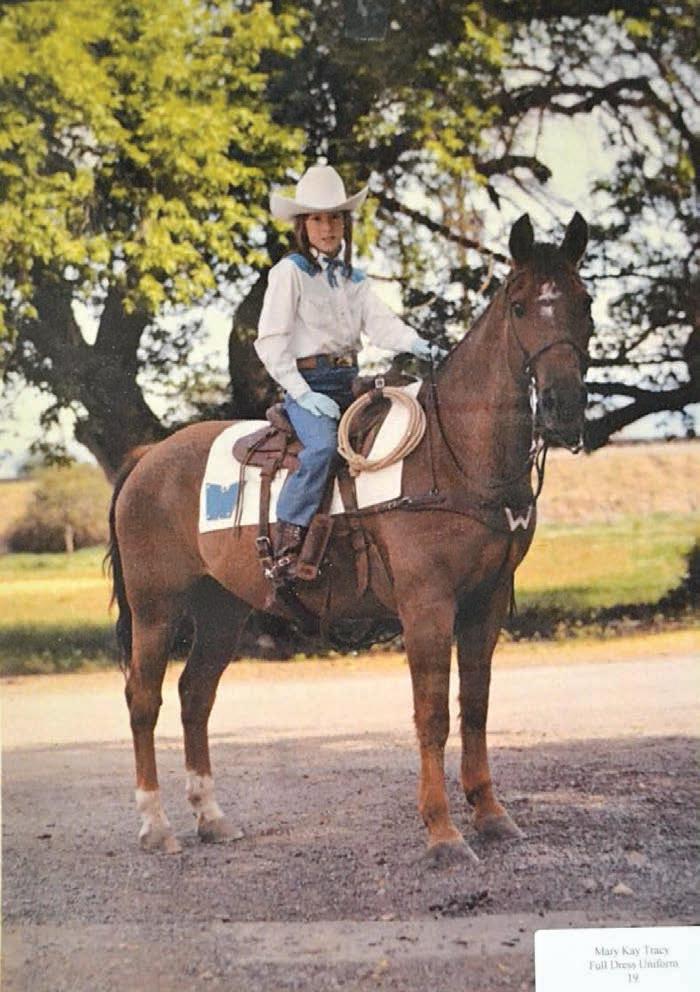
for uniforms, gear, transportation, and to keep the team competitive and looking sharp. Local merchants and community members responded generously in purchasing advertising in the Horse Show Program. As Bryce Baker had predicted, the Wranglerettes came to dominate regional drill team competitions winning numerous WSHA Drill Team State Championships. Wranglerette alumni fondly remember the support and dedication of their adult advisors. Bryce Baker, Cal Shull, Carol Clerf Martinez, Dorothy Cole, Roberta Roberts, Linda Anderson Dozier, George Mills, Louie Brune, Vern Burk, George Mathews, Jack Ferguson, Al Frink, Kathy Merrill, Robin Turpin, Stan Mainwaring, Cliff Gage and many, many more helped the girls make the team successful. Another person who the girls loved and trusted to haul their horses to competitions and parades throughout the Northwest for many years was Rod Hussey.
In the mid-1970s a new generation of Wranglerettes
came onto the scene, replacing the classic turquoise and white fringed outfits with more modern gold blazers, slacks, and feathered hats. The Wranglerettes continued to compete and serve as the Ellensburg Rodeo’s ambassadors until 1986. By then almost all of the state’s drill teams were gone, replaced by 4-H horse clubs and other opportunities for cowgirls to ride and compete. The Ellensburg Rodeo Wranglerettes rode in the 1986 Ellensburg Rodeo parade and grand entry and afterwards the club disbanded.
Today [1997], there are 232 Ellensburg Rodeo Wranglerette alumni, ranging in age from the 20s through the 50s. They are scattered throughout the Kittitas Valley, the Pacific Northwest, and, quite literally, the world. These cowgirls share a unique bond–they helped to shape a special era in the history of the Ellensburg Rodeo.


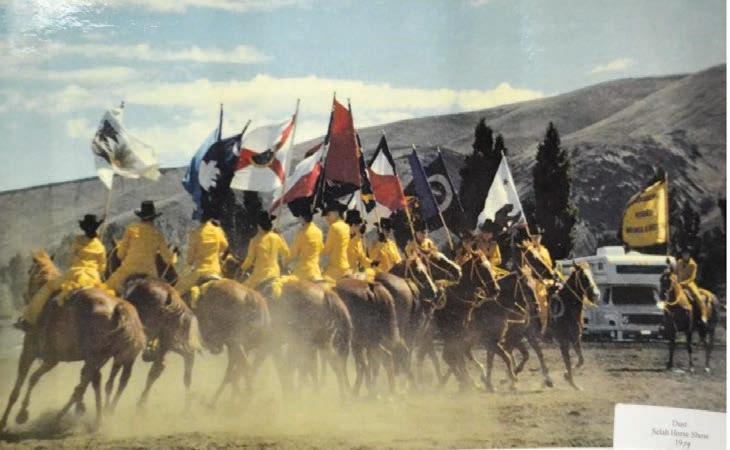
Above:
Photos


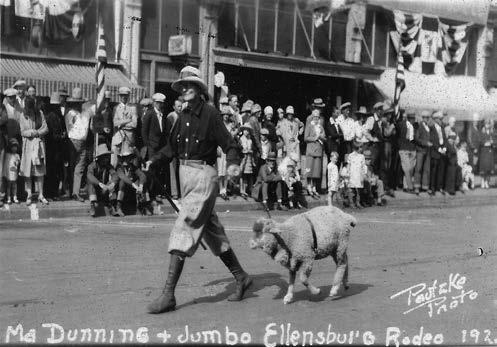



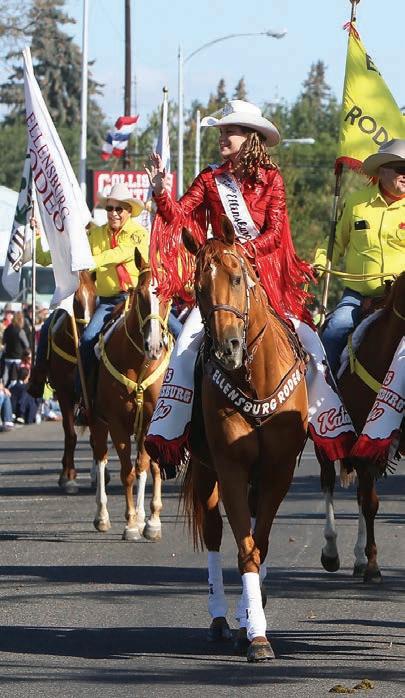
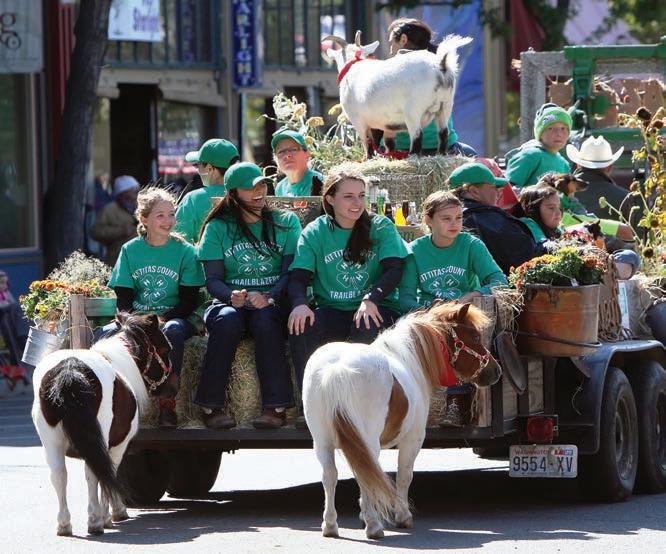
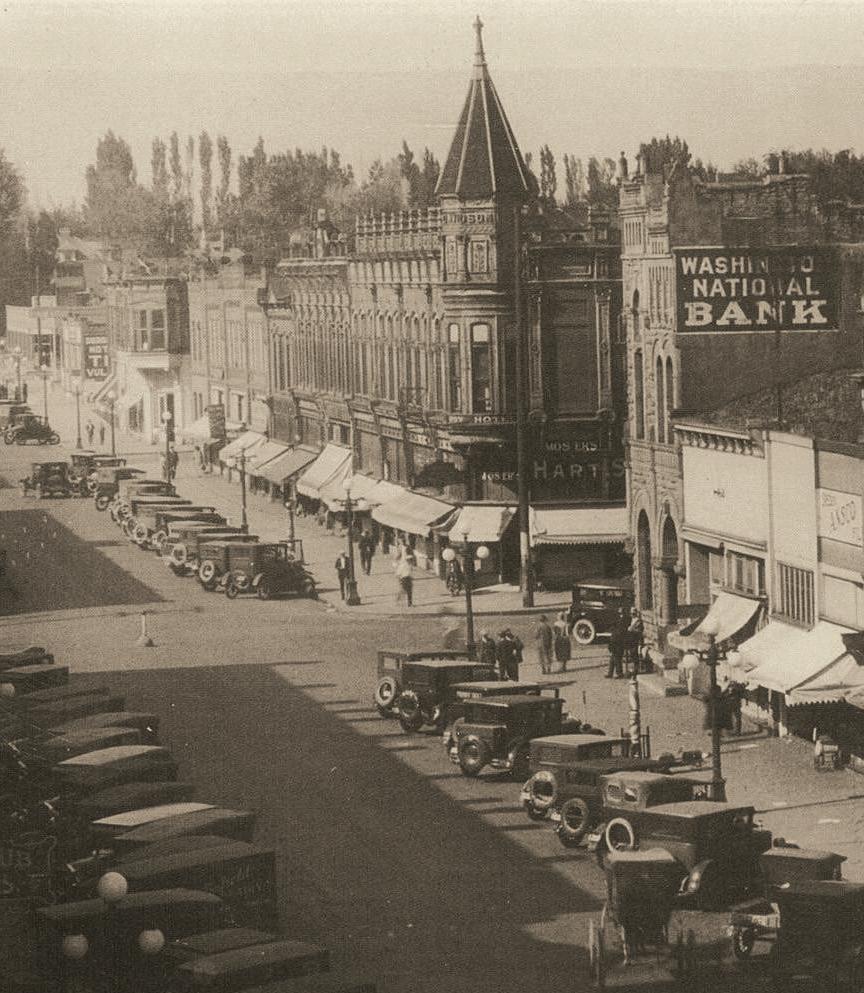
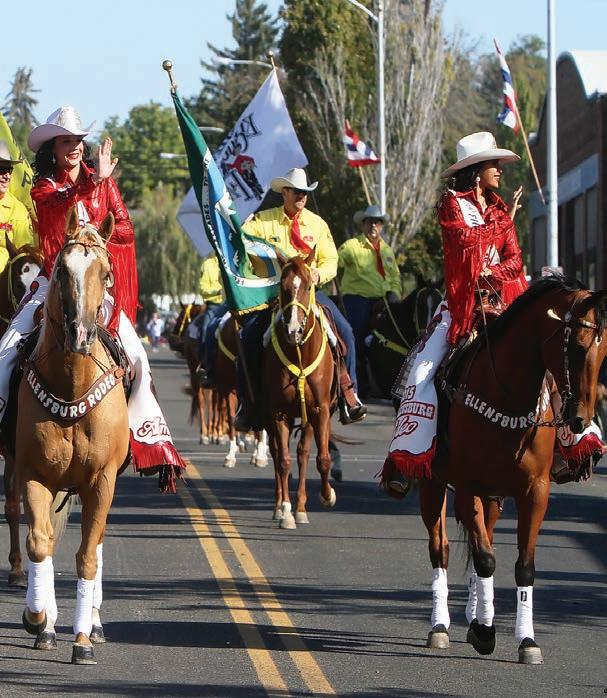
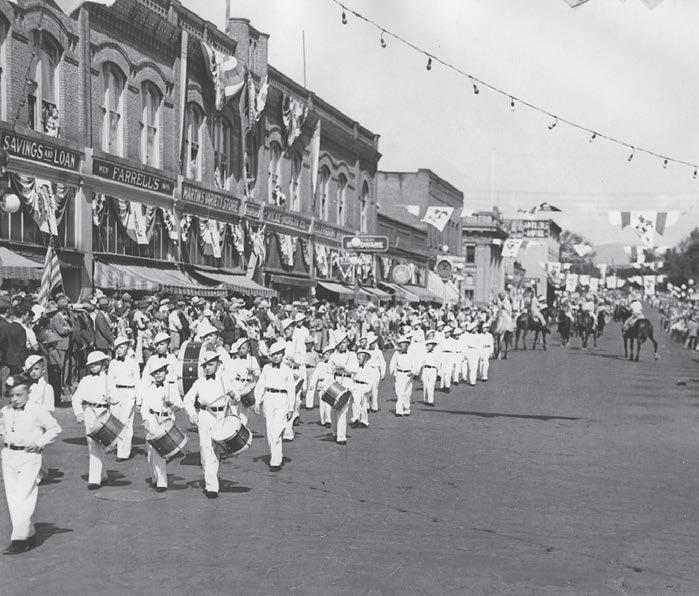




Cowboys, Indians, posses, bagpipes, marching bands, kids, clowns, horses and queens: the Ellensburg Rodeo Parade has been a popular and integral part of Rodeo Weekend since 1923. Be sure to save the date! August 30, 9:30 a.m. in historic downtown Ellensburg. Get there early to get a good seat!
— Photos courtesy of Washington Rural Heritage, Ellensburg Rodeo Hall of Fame and the Daily Record
The Ellensburg Posse was formed over the years 1939, 1940 and 1941. The mentors and founders were Dr. John P. Richardson, local veterinarian and Rodeo Board member; Dr. Carl Ostrander, local medical doctor; and Robert McConnell, president of the Washington State Normal School — now known as Central Washington University. All three were serving on the Ellensburg Rodeo Board at the time.
The doctors had made several trips to California for medical conventions and clinics, where they saw the San Francisco Mounted Sheriff’s Posse with their golden palominos and silver saddles. They thought something like that would be a great fit for the Ellensburg Rodeo and could be used to help advertise it. They also had a chance to watch the Oregon Governor’s Brigade and brought both ideas back to town.
Clifford Kaynor, editor of the Evening Record, jumped on board to help promote the concept in the community. In 1939, it was mostly about talking to local ranchers, businessmen and horsemen. By summer 1940, things started taking shape. They brought in Dave Adams, a former Cavalry drill master, and his assistant Herman Turner, to help train and organize drills. Many early members were also on the Rodeo Board or local ranchers and professionals.
In the beginning riders could use any color horse they owned. Drill Master Adams designed four or five different drills arranging horses by color — pintos, blacks, whites, grays, bays and sorrels — for visual effect. Then the war broke out on Dec. 7, 1941. But earlier that year, the Posse had 26 active members and made its first public appearance in the 1941 Ellensburg Rodeo Parade. They performed a 14-minute drill at the Rodeo — a show that would become the hallmark we now call the Posse Night Show.
The riders were deputized and holstered guns were worn. No music — just the sound of hooves and sharp military commands from the drill master or his assistant. Hundreds watched practice sessions Thursday evenings from April through September, either atop Craig’s Hill or in the new 5,000-seat east hillside grandstands.
The uniforms were something special — custom made by Nudie’s of Hollywood and V. Turk Brothers of Van Nuys, Calif. Khaki gabardine pants and shirts with green trim and yokes, short Bolero jackets, white scarves and brown derby-style hats.
When the war hit full force large public gatherings were restricted and gas was rationed. From 1942 to 1944, the Rodeo was officially canceled. Still, the Rodeo Board and Posse got clearance from the Governor’s office to hold small community events. That’s when the Posse Wives Auxiliary stepped in and organized things like Jeep rides with military personnel from Moses Lake, Ephrata and Bowers Field. Donations went to the USO and to furnish the
YMCA Military Lounge. Bob Neely reported more than $40,000 in war bonds and stamps was raised during those years.
Entertainment included large local horse shows and reviving the old “Blazers of the Trail” Indian pageant, which ran from 1928–1939. Written by H.C. Fish with help from Floy Rossman and directed by Miss Nellie Burke from the State Normal School, it involved 200–250 local participants, including Yakama and Colville Tribal members, and took months of practice. During the war years, the Auxiliary adapted parts of the original into the new Posse events, later renamed “Spirit of the Trail.”
From those events grew what we now call Posse Night Shows, still a core part of the Rodeo. In addition to drill performances,

the Posse helped run Pony Express relay races, Cliff Races, War Bonnet Races and Chuck Wagon Races. We became known as “Ambassadors on Horseback” and traveled with the Rodeo Royal Court to parades and events across the state.
The Posse is members of the State Posse Association, competing in shows and attending state meets in places like Yakima, Omak, Walla Walla, Wenatchee, Spokane and Moses Lake. Our trophies still line the halls of the Kittitas County Courthouse. In 1947, we even rode in the Seattle SeaFair and the Roslyn Coal Festival Parade. I still have the original Posse flag carried in parades until 1969.
On Jan. 10, 1944, six trustees filed to certify the Ellensburg Rodeo Posse as an official mounted equine group under

Above: Several of the Ellensburg Rodeo Posse members lined up for this photograph. Unfortunately not all those pictured could be identified. If you know anyone in this photo please send the information to editor1883kittitascounty@gmail.com.
Right: Some Posse members with their trophies. Shown standing left to right: Rex Rice, Chuck Scott, Frank Oechsner, Everett
Stewart Allen, unknown, Don Klampher and Cal Shull. Photos courtesy of the Ellensburg Rodeo Hall of Fame
Washington State law. On July 11, 24 of the original 26 members traveled to Olympia to sign the papers at a Capitol Dome reception. That made us the first certified equine Posse in Washington, alongside the Oregon Governor’s Brigade. King County’s Posse followed shortly after. At one point, our bylaws capped membership at 199, but the Posse reached its peak with 75 members between 1945 and 1948.
In 1947, we acquired an unused military building at Bowers Field for our clubhouse—complete with stoves, restrooms, dining hall and a four-acre field we fenced for visiting Posse horses. We even leased the nearby shooting range for overflow horse boarding.
The clubhouse hosted meetings, dances, oyster feeds and gaming nights. After nearly 50 years the Port Commission reclaimed the land but not before we saved the branded wood boards from the dance hall—each marked with Posse and Rodeo brands of the day.
In 1946, the Posse land at the base of Craig’s Hill for the Posse barns. Tragically, both barns were lost in a fire on July 4, 1950. But with Rodeo just weeks away, local unions and volunteers stepped up. They rebuilt both barns in record time—done by Aug. 27.
In 1951, we voted that all Posse members must ride sorrel horses. Later, thanks to Rodney Hussey, we transported horses to Spokane, Olympia and Seattle
parades by semi-truck. Rod required all horses to be muzzled to prevent biting, and each had a specific travel partner. This went on for 20 years until Rod could no longer drive.
The Ellensburg and King County Posses have always shared a special bond. For me personally, one dream was to ride with the flag and set the pivots during the Grand Entry of the Ellensburg Rodeo. Thanks to Bill Woodworth and Scott Brown, that dream became a reality—a memory I’ll always carry.
— By Posse historian Oscar Berger. Berger has held every Posse office serveral times throughout his 48-year (and counting) tenure with the Posse.

The first non-native Americans to reside in Cle Elum were Thomas L. Gamble and Walter J. Reed, who, in 1883, established adjacent homesteads on land where downtown Cle Elum is located today. Each built a cabin on their respective 60-acre properties, making them, in essence, the founding fathers of the future town.
Less than a year later, coal deposits were discovered in the hills around what is now the community of Roslyn. The discovery came at an opportune time because the Northern Pacific Railroad was just building a line to Puget Sound through the region.
The enterprising Gamble and Reed immediately recognized their land holdings were ideally located near Roslyn and the rail line that was being built. Additionally, the coal discovery and the presence of extensive forest land could provide the railroad with coal for its locomotives and timber for ties, trestles, and tunnels.
In 1884, Gamble reached out to the railroad and successfully persuaded it to construct a depot on his land. To sweeten the pot further, Gamble and a partner, Tom Johnson, erected that many considered to be the largest saw mill in the central or eastern Nevada region to supply timber to the railroad.
The plan worked when, in October 1886, the railroad line reached Cle Elum and the first train arrived at the new depot. That year, Gamble plated his land as a townsite. According to some accounts, his wife insisted the town have unusually wide streets because she felt they would be necessary when the settlement became “another Pittsburgh.”
Reed and his wife, Gamble, and Johnson also agreed this new settlement needed a name. They chose Cle Elum (sometimes spelled Cle-Elum), which was derived from the Native American name for the river that ran through the area. The Kittitas tribal name was, Tle-el-Lum, which translated as “swift water.”
According to “The History of Klickitat, Yakima and Kittitas Counties, Washington,” published in 1904, shortly after Cle Elum successfully incorporated as a community in 1902, the Northern Pacific Railroad arbitrarily changed the town’s name to Cle-Alum because the letter substitution would make it an easier name for telegraph operators to type (apparently tapping two “e’s” in a row on a telegraph key was thought to be challenging).
The railroad also attached the revised name on its depot in the community and even used the name “Clealum Railroad Company” on shares of its stock.
Apparently, local employees of the U.S. Postal Service liked the new name and took it a step further. In 1903, they changed the name of the post office to Clealum. “This action aroused a storm of indignation among the town’s residents and friends, for by the change the old name was destroyed and its significance entirely lost,” noted the Kittitas County history book. “Besides, the new spelling was not in accord with the city’s corporate name. Moreover, considerable Cle-Elum mail found its way to Clallam, across the range.”
In December 1904, citizens formally demanded the post office return
the name of the community to its original spelling and appealed the name change to the postal authorities and the U.S. Geographic Board. “Is it Cle-Elum or Clealum? This is a question that has been before the post office department and the before the board of geographic names, and a final determination is yet to be reached,” said the Tacoma News-Tribune in 1904. “In the state of Washington it is and always has been ‘Cle-Elum,’ but of late minor employees in the postal service, on authority yet to be disclosed, have assumed to make one word of it and change the spelling.”
The News-Tribune added that residents had complained to their Congressman, Representative Wesley L. Jones of North Yakima, who took up their case to postal officials. He was assured that the name change had not been authorized by them and suggested the matter be resolved by the U.S. Geographic Board, who, they thought had made the change.
In 1907, the matter had still not been completely resolved, perhaps because the railroad continued to use the name. The Cle Elum Echo newspaper editorialized: “The name ‘Clealum’ decorates the new depot. There is no such place as ‘Clealum,’ and no such word, so far as we can learn. This city is incorporated under the name CLE ELUM (two words and two ‘Es’ coming together).”

Headline on a news article about the Cle Elum-Clealum name controversy that appeared in the Tacoma NewsTribune on March 31, 1904. Contributed photo
The Echo went on to say, “The post office is Cle Elum; the Indian word or name is Cle Elum, the river just west of the city is Cle Elum, the mining district is Cle Elum, one of the most beautiful lakes in the United States was named by the Indians and is Cle Elum, yet a sign on a little dinky building that the railroad company calls a depot informs the traveling public that the train has arrived at ‘Clealum,’ and as there is no such place it would be just as sensible to have the sign read ‘Nowhere.’”
Another local paper, the Cle Elum Record, also joined the fight, editorializing in September of that year that “Ever since the Northern Pacific hung up the word ‘Clealum’ on the new depot, we have been besieged with inquiries as to the meaning of the word.”
With tongue clearly in cheek, the Record said it had consulted with a Tacoma News lexicographer “and a number of walking encyclopaedias” who determined Cle was derived from the Egyptian name, Cleopatra, meaning “not clear or dirty.” Alum is the name of a mineral salt that is a principal ingredient in baking soda. Thus, according to the paper, the



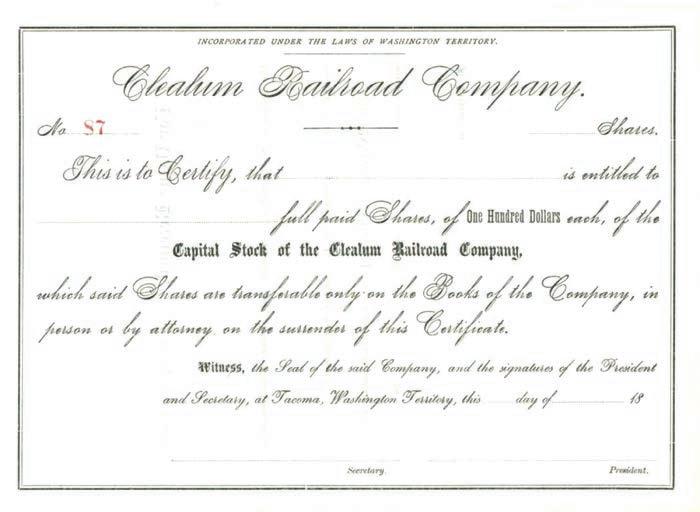
word Clealum means “dirty baking powder.”
“Nice name, isn’t it, to force upon a self-respecting community?” the Record concluded.
In 1909, the Geographic Board ruled on the matter, agreeing with the citizens of Cle Elum. Yet, despite the victory—and the fact the railroad finally backed down after 1908—some mistakes take time to correct. In fact, the misspelled name, Clealum, continued to appear in some newspapers as late as 1920.
Right: A stock certificate from the 1890s for the Clealum Railroad Company, which operated from 1886 to 1898 and was part of the Northern Pacific Railroad. Contributed photo
— Richard Moreno is the author of 14 books, including Frontier Fake News: Nevada’s Sagebrush Hoaxsters and Humorists and the forthcoming Washington Historic Places on the National Register. He is the former director of executive communications at Central Washington University and was honored with the Nevada Writers Hall of Fame Silver Pen Award in 2007.



The beef industry provided the foundation for the settlement of the Kittitas Valley and for more than 165 years has had a major impact on the county.
Kittitas was “cow country” before the first settlers homesteaded in the valley. Large cattle drives through the valley were spurred by the discovery of gold in the Pacific Northwest. At the time, Kittitas Valley was open range and was a vast area of meadow and grasslands. During this era cattle were mostly Shorthorns and Durhams.
Ben Snipes was the first to bring cattle into the valley in 1860. Based in Yakima, Snipes moved thousands of cattle to the Kittitas Valley for summer range. The cattle grazed on lush bunchgrass and drank from clear, cold streams. AJ Splawn also trailed cattle through the Kittitas Valley in 1861 on his way to the mines of British Columbia. Soon thousands of cattle driven here for summer range grazed on bunchgrass. It was cattle paradise.
The first stockman to settle here and file a land claim was Tillman Houser in the spring of 1868. Discouraged with the increasing population in Yakima Valley and seeing the importance of the Kittitas Valley as a cattle center, F.M. Thorp and C.J. Splawn settled on Taneum Creek. Thousands of acres of freegrazing ground lured settlers into the valley. By 1869 the valley was growing in importance as a gathering place for cattle drives and a place of settlement. The Homestead Act brought families to Kittitas County and fences started breaking up the open range.
Some of the first families to settle in the Kittitas Valley were the Germans, Bulls, Cookes, Schneblys, McEwans, Barnharts, Habermans, Raders, Olmsteads, Geddis, Smithsons, Coffns and many, many more.
Survival for these early ranchers wasn’t easy. The supply point
was The Dalles —150 miles away — and everything the ranchers needed came by wagon or pack horse including the mail.
Washington’s Oldest Registered Brand
Kittitas County hails Washington state’s oldest registered brand. The Bar Balloon brand, or Balloon Bar brand, was first used in Missouri by the Painter family. Then in 1848 it was brought to Willamette Valley when this state was part of the Oregon Territory. David Schnebly married into the Painter family in 1860 and gathered a band of cattle to start his stock business in the Walla Walla Valley using the Ballon Bar brand.
On June 11, 1868, at a time when Washington Territory began recording brands, the Balloon Bar brand was submitted to Walla Walla authorities on a piece of leather with the brand burned in. Inked within the balloon on the original registration is “Calvin and Painter, filed June 22, 1868 T.H. Blewett, Co. Aud., by H.M. Chase, Deputy.”
Philip and Charles, sons of David Schnebly, came to the Kittitas Valley in 1871 where they established themselves in the stock business. The Schneblys ran large herds of cattle that grazed on open range from the valley floor, north to the top of Colockum Pass and east to the Columbia River. Six generations and 157 years later, this brand is still found on livestock grazing in the Kittitas Valley.By the early 1870s, large cattle herds had been built up in the Kittitas Valley. A.J. Splawn fenced off a pasture for a 10,000-head holding pen in what is now downtown Ellensburg, back in 1871. Cattle were driven to the mining country in Idaho, Okanogan and to British Columbia. Before long those areas began to raise their own cattle and the markets were lost. Cattlemen found another market in Puget Sound area which led them to drive large herds over Snoqualmie Pass (a wagon road at that time) to the Seattle market. An oversupply of cattle and

a nationwide depression in 1873 lead to a decline in the price of beef to $.03 a pound. This oversupply and general depression continued to depress the market until 1876. In a three-month period in 1877, 3,000 head were moved over Snoqualmie Pass.
By 1879, the market began to recover because of heavy purchasing from the mid-west stockyards, and in 1879 about 20,000 head of cattle were moved out of the Kittitas Valley bringing $17 per head. The hard winter of 1880-1881 killed off better than half the cattle in Eastern Washington and Oregon. Ben Snipes reportedly lost 30,000 head of cattle. The switch from wide-open ranges to fenced pastures and stacked hay was a slow transition. Cattlemen were unhappy with the encroachment on rangeland. Settlers took advantage of land laws, fencing the land and fencing the best watering places which inconvenienced the open range stockmen. However, with more severe winters, cattlemen realized the advantages of storing hay and Kittitas Valley cattlemen began to fence land for growing hay for winter feed.
In November 1883, the year Kittitas officially became a county, herds were building back up, although not fully restored. However, Eastern buyers were purchasing as many marketable cattle as they could find. Cattle drives were not over and in 1883 more than 30,000 head of cattle left Washington and Oregon for Montana. The price for cattle was $50.60 per head and cattle were “as good as gold.” Completion of the Northern Pacific in 1886 changed the cattle trade as beef was being shipped to the West Coast and to Eastern markets. In 1886, the Northern Pacific Railroad reported 50,900 head of cattle shipped into Montana from Washington alone.
By 1889, stockraisers began buying railroad land which they fenced for pasture. Another hard winter in 18891890 was devastating for stockmen; thousands of head of cattle were lost. They started to diversify and began farming in preparation for winter feed. Ihis brought about a change in stock handling and reduced the size of herds. This marked the end of the large, “freerange” cattle owner in the Kittitas Valley.
In 1903, the Washington Livestock Association was formed and concerned itself with all phases of livestock production including horses, cattle, mules, sheep, hogs and dairying. At the fourth meeting held in Spokane in 1908, A.J. Splawn was elected the president. He had been a stockman in the Kittitas Valley for 48 years. The Ellensburg Auxiliary of the Washington Livestock Association was formed in February

1908, but it organized and disbanded the same year. Within 10 years, scattered county associations were formed that were geared to the interests of cattlemen. The Washington Cattlemen’s Association was organized, but it wasn’t until Dec. 30, 1938 that the Kittitas County Cattlemen’s Association was founded and became affiliated with the WCA. Rufus Schnebly was elected the first president, Al Sorenson was vice-president, W.O. Passmore was secretary and Fred Adams was elected treasurer. Directors were Jake Frederick and Jerome Contratto. Between 1945 and 1950, there were more than 300 beef ranch operations in Kittitas County, some of which included owned or leased rangeland. There were 20,360 head of beef cattle and calves consisting of 39% cows (2 years and older), 41% steer, heifer and bull calves and 2% bulls. Tie percentages indicate a predominance of cow-calf operations including commercial and purebred herds.
Kittitas County is proud to be the home of the headquarters of the Washington Cattlemen’s Association today. Significant strides have been made in raising more beef on less land. Kittitas County beef producers are marketing great beef to discriminating buyers. From past to present, the beef producers and their families in Kittitas County have taken an active interest in community affairs serving on school boards, county boards, committees and commissions. Because of price controls and rising feed costs in the early 1970s, county cattlemen diversified and now produce some of the finest hay grown in the West marketed to numerous states as well as Pacific Rim and European nations.
Beef producers have come and gone, and some planted roots for future generations who still ranch on heritage land. In one way or another they all left their mark in the history of Kittitas County.
— By Gail Shelton
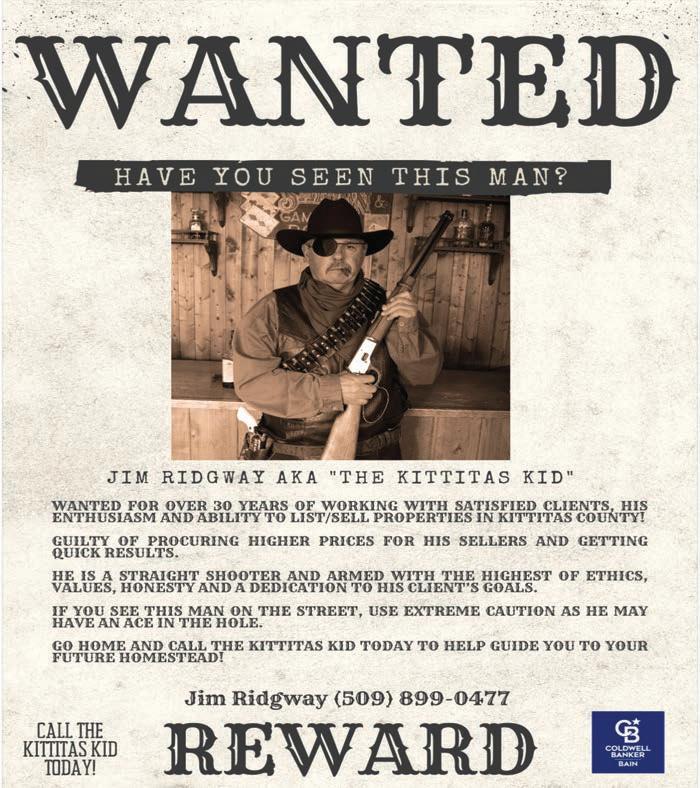

The
‘Wall That Heals’ comes to Ellensburg
In September, Ellensburg will host a powerful and poignant tribute to those who served and sacrificed during the Vietnam War. “The Wall That Heals,” a three-quarter scale replica of the Vietnam Veterans Memorial in Washington, D.C., will be on display at Rotary Park from Sept. 4 - 7. This moving exhibit offers a unique opportunity for the community to reflect, honor and heal. This project is a collaborative endeavor hosted by your Kittitas County Rotary Clubs, with the Ellensburg Downtown Rotary Club taking the lead on the planning efforts. The effort has also received generous support from community sponsors and individuals as well as logistical help from the City of Ellensburg.

No direct financial contribution from the city is has been requested, but only in-kind support from city departments including Parks & Recreation and the Ellensburg Police Department. Community spirit is at the heart of this initiative, and volunteers are stepping up to do the heavy lifting.
Arrival & Welcome Procession
The Wall arrive in Ellensburg on Sept. 2. A welcome procession will depart promptly at 2 p.m. from the staging area
See WALL on Page27

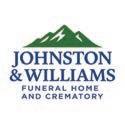









Hosted by your Kittitas County Rotary Clubs with immense support from the City of Ellensburg

Janis Anderson
1/2 gallon ice cream
1 lb. brown sugar
1 lb. butter
Rum
Mix ingredients - except the rum - then place into the freezer to use as needed. Place frozen mix and rum into a mug of hot water and enjoy. Portion of mix and rum to be determined by choice.
A cowboy friend from Oregon shared this recipe with Janis’ family. She said it is a wonderful mix to have on hand.

1 - 8 qt. box of instant dry milk
1 lb. box of instant chocolate
1 1/2 C powdered sugar
1 6 oz. jar of Coffee Mate
Mix the ingredients together and

This is a real quick way to go if you are busy. You can slice and use for sandwiches. If you like it sweet use ketchup or chili sauce.
1 lb. ground beef
1/2 C quick oatmeal
store in a large container. Use between a 1/4 and 1/3 cup of mix to 1 cup hot water.
Grandma Chloe Weidenbach
1 egg, beaten
1/2 C sugar
2T butter, melted
3 C flour
2t baking soda
3/4 C molasses
2 C hot water
Mix ingredients and bake in a 9 x 13 pan at 350 degrees for about 45 minutes.
1 egg salt pepper onion
1- 6 oz. can of tomato paste
Mix beef with oatmeal, salt and pepper and onion to taste. Blend. Add half can of tomato
paste and mix with hands or spoon. Put into a loaf pan and spread with the remaining tomato paste. Bake at 350 to 400 degrees for one hour.
All recipes are courtesy of “Good Lookin’ Cookin’ with the Rodeo Grandmas” cookbook. Each recipe for 1883 was selected by Grandma Chloe.
Roping Club members played a vital part in the rodeo’s success
It began as a way to have some Sunday fun. Local ranchers built their own arenas so neighbors and area friends would come to rope calve and a competitive spirit took over. It became a part of life in the Kittitas Valley. Roping calves was not just a Sunday activity — it was a necessary skill frequently used in every day ranch work. Today that spirit still exists and the Kittitas County Calf Roping Club continues to be a growing ground for ropers and horsemen–and women–to improve their abilities as it has for more than 60 years.
For its hand in aiding the Ellensburg Rodeo achieve world fame, the club is among those inducted into the Ellensburg Rodeo Hall of Fame. The ropers incorporated in 1947, but its members’ activities, while loosely organized, began much earlier with the Ferguson, Wyatt, Jenkins, Minor, Morrison, Roberts and Porter ropers helping lead the way. When the Ellensburg Rodeo began it was these same ropers who were johnny-on-the-spot to help make it a success — as volunteers working the roping and bulldogging chutes and as competitors, many on a par with the rodeo professionals. That, too, still exists. Dr. Ken MacRae, long the arena director for the rodeo, says, “the members have always been very supportive of the rodeo; members helped when and where needed. And they have provided rodeo board members, too. If you lived here and were interested in riding and rodeo and wanted to improve your roping skills you belonged.”
Since 1945, the roping club members competed to qualify for
the county calf roping held during the Ellensburg Rodeo. That began when locals were not permitted to compete at the rodeo if they were not members of the Turtles Association, the forerunner of what is now the Professional Rodeo Cowboys Association. Competing before the hometown fans was important so the rodeo board added the county roping event. (There was for a time an amateur, or county, bronc-riding event which lasted for a few years). The format for qualifying for the Labor Day weekend county roping has changed. Now there are four elimination ropings throughout the summer and the top eight ropers, qualify to rope at the rodeo. Some of the top eight may opt to compete in the PRCA sanctioned tie-down roping (and are PRCA members), so the next placed roper gets the call to rope in the county roping. While the county championship has been passed around to many members, the Minor family has won more than a dozen titles with more likely to come. Buck and sons Pat and Brent have been tough to beat — Pat having won seven times and Brent six and still active. Solly Houser and Danny Orcutt each won five times. Fans also see the members volunteering to help push cattle out of the arena — for years it was Frank Wallace and Tex Taliaferro — or younger members running out to untie calves during the PRCA events. They have helped sort and earmark calves and steers for the rodeo’s daily draws. (Each pro cowboy entry has his calf or steer drawn by chance). MacRae said, “All you had to do was give a call and they’d be there to help. We’d tie down the calves before they were roped


during the rodeo performances and that was a long day of sweaty work.”
Throughout the year the club promotes roping and horsemanship through play days and clinics, monthly ropings where points are totaled. At year’s end high-point winners receive awards and prizes at the annual banquet. In the late 1970s women were included as members of the club and breakaway roping was added to the other roping events. Membership is open to permanent county residents and today there are 65 active members (15 families). Another notable activity is the sponsorship of the Northwest five head tie-down roping, team roping and steer wrestling championship. The three-day Memorial Day weekend event attracts top contestants from Canada and the western half of the U.S. including such “name” entries as Joe Beaver, Brent Lewis, Jeff Coehlo, Dean Oliver and Brad Goodrich. Goodrich and Allen Bach are former roping club members who have gone on to the highest levels of pro rodeo including the National Finals Rodeo. Bach is a three-time world champion team roper and Goodrich is a top 15 roper and bulldogger — and 1984 county roping champ.


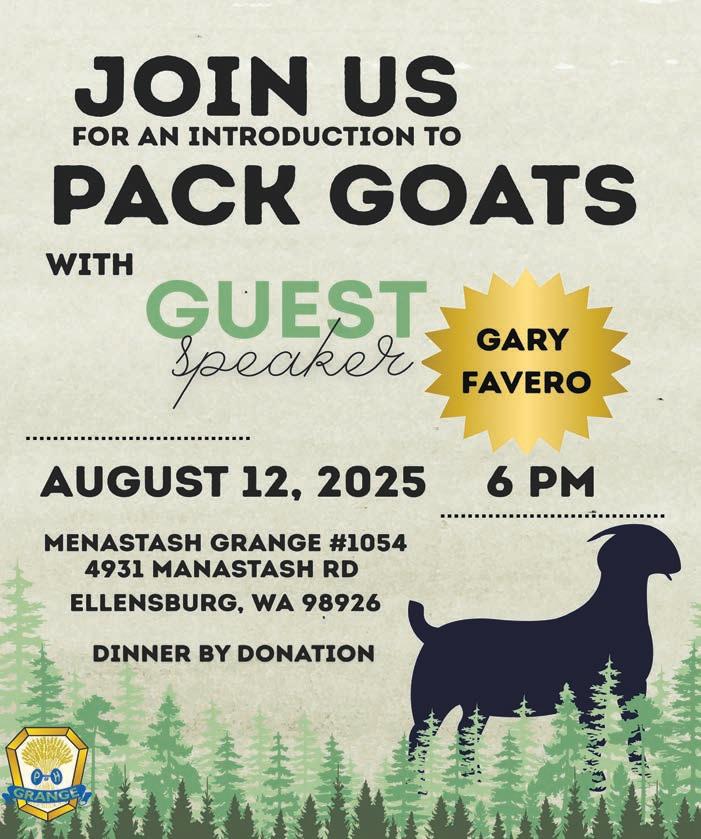
August 1
Bingo, Whipsaw Brewing, 6pm
Roslyn Music Jam, Roslyn Creative Center, 6:30pm
Trivia, Iron Horse Brewery, 6:30pm
August 7
Poetry Open Mic, Club 301, 6pm
Wolf Pack Live Music, Unity Park, 6:30pm

Ellensburg Posse Junior Rodeo, Rodeo Arena, 8am Unity Park Unveiling Ceremony, Unity Park, 5:30pm Lance & Leah from Nashville, Nodding Donkey, 7pm Rusty Cage, Gard Vintners, 6pm Minimum Wage, Valo Tasting Room, 6pm Bouncy House, Roslyn Yard, 11am
Concert Series Nelson Farm, Suncadia, 6pm Basically, Cornerstone Italian Kitchen, 7pm Loco Motion, Smokeys on Pearl, 6pm The Knuckleheads, Old Skool’s, 7pm Micah J, American Legion, 7pm
August 2
Smith House and Cabin, Olmstead State Park, 9am Backpack Drive, Hearthstone Senior Living, 2pm
Ellensburg Farmers Market, Downtown, 9am
Bocce Ball Tournament, Cle Elum Fireman’s Park, 9am Women’s Mountain Bike Ride, Roslyn Yard, 9am Kittitas County Garden Demo, Armory Kittitas County Fairgrounds, 10am
Adrienne Eliades Ceramics Workshop, Gallery One, 10am
Jeannie Johnson Art in the Park, Unity Park, 10am Free Parrot Show, Roslyn Creative Center, 11:30am Minimum Wage Band, Cornerstone Italian Kitchen, 7pm
Bingo Pigeons, Cle Elum Eagles, 7pm Youth Gladiator Dash, Rotary Park, 9:30am Under the Covers, Brick Saloon, 9pm Traveling Miles Band, Nodding Donkey, 7pm Billy Mac & Late for Supper, Wheel Line Cider, 4pm Crackin’ Crab for Cancer, Kittitas Valley Event Center, 5pm Wolfpack Serenade, Iron Horse Brewery, 7pm Micah J, Stovehouse Suncadia, 6pm
August 3
Geology Activities, Gingko Petrified Forest, 9am Roslyn Farmers Market, Roslyn, 10am
August 5
Creative Writing Class, Peers Rising, 4:30pm Weaving Circle, KC Historical Museum, 6pm Trivia, Whipsaw Brewing, 6pm
August 5
National Night Out, Cle Elum, 5pm Master Gardener Plant Clinic, Armory, 11:30am Trivia Tuesday, Rock & Reef Brewing, 6pm Poirot Tuesdays, 420 Loft Art Gallery, 7pm
August 6
Magic Show, Roslyn Public Library, 2pm Bike Night, The Porch, 6pm
Trivia, Iron Horse Brewery, 4pm
Zimfest, CWU Campus, 7:30pm
August 8
The Professors, Cornerstone Italian Kitchen, 7pm
Mel Peterson, Suncadia Lodge, 6pm
Afton Prator, Nodding Donkey, 7pm
Micro Maidens Dwarf Dancers, The Ridge, 8pm
Jukebox Central, Gard Vintners, 6pm
Zimfest, CWU Campus, 7:30pm
Concert Series Nelson Farm, Suncadia, 6pm
August 9
Ellensburg Farmers Market, Downtown, 9am
Mel & Dre, Wheel Line Cider,4pm
Rusty Cage, Whipsaw Brewing, 6pm
Contraband Band, Nodding Donkey, 7pm
Canyoneros, Cle Elum Eagles, 7pm
Jared Graham, Cornerstone Italian Kitchen, 7pm
The Hipsters, The Brick, 9pm
KCFD1 Annual Car & Bike Show, Thorp FD, 9am Anarchy, Old Skool’s, 7pm
August 10
Zimfest, CWU Campus, 7:30pm
Roslyn Farmers Market, Roslyn, 10am
August 11
Trivia, Whipsaw Brewing, 6pm
VTC Readers Theatre, Gard Vintners, 6:30pm
August 12
Master Gardeners Clinic, Armory, 11:30am
Crochet with Purpose, Peers Rising, 5:45pm Trivia, Rock & Reef Brewing, 6pm
How Beer Might Save Democracy, Iron Horse Brewery, 6pm
Perseid Meteor Shower, Wild Horse Wind Farm, 7pm
Poirot Tuesday, 420 Loft Art Gallery, 7pm
A Midsummer Night’s Dream, Unity Park, 7pm
August 13
Bingo, Whipsaw Brewing, 6pm
Trivia, Iron Horse Brewery, 6:30pm
A Midsummer Night’s Dream, Unity Park, 7pm
August 14
Jake McVay, Dru Bru Cle Elum, 5:30pm
Riley & Nicole, Unity Park, 6:30pm Bunco, Iron Horse Brewery, 4pm
August 15
Kage Dallas, Time Out Saloon, 8pm Vaught Rock, Nodding Donkey, 7pm
Jodi Ryan, Gard Vintners, 6pm
Blank Canvas Party, Gallery One, 6pm
Concert Series Nelson Farm, Suncadia, 6pm
Poetry Open Mic, Roslyn Public Library, 7pm
A Midsummer Night’s Dream, Unity Park, 7pm
Solomon, Cornerstone Italian Kitchen, 7pm
Micah J, The Source Suncadia, 6pm
August 16
Ellensburg Rodeo Kickoff Breakfast, downtown, 7 am
Krusin’ Kittitas Car Show & Burnouts, Kittitas, 10am
Billy Mac & Late for Supper, Cornerstone Italian Kitchen, 7pm
Ride to Defeat ALS, Dru Bru Cle Elum, 7am
Junior Rodeo Parade, Ellensburg Skate Park, Noon Ellensburg Farmers Market, Downtown, 9am
Plein Air Paint Day, Carpenter House Museum, 9am
Art in the Park with Karl Schwisow, Unity Park, 10am
Cle Elum Cars & Coffee, Dru Bru Cle Elum, 10am
Cornhole Tournament, Downtown Kittitas, 4pm
Karaoke, Nodding Donkey, 7pm
Woods Creek, Cle Elum Eagles, 7pm
Harmon & Miles, Wheel Line Cider, 4pm
Dog Man, Roslyn Yard, 8pm
August 17
Cle Elum National NonProfit Day, Cle Elum, 11am
Roslyn Farmers Market, Downtown, 10am
Whiskey Dinner Night, The Ridge, 6pm
August 18
Trivial, Whipsaw Brewing, 6pm
August 19
Trivia, Rock & Reef Brewing, 6pm
Poirot Tuesday, 420 Loft Art Gallery, 7pm
August 20
Abbigale, Kittitas Cafe Kittitas, 5pm
Mel Peterson, Downtown Ellensburg, 4pm
Ellensburg Night Market, Downtown, 4pm Bingo, Whipsaw, 6pm
Trivia, Iron Horse Brewery, 6:30pm
August 21
Speaker Series: Prohibition in Upper County, Carpenter House Cle Elum, 5:30pm
Ellensburg Big Band, Unity Park, 6:30pm
Music in the Brick House Gardens, 6pm
WALL: Continued from Page 22
at Opportunity Street and Umptanum Road (near Carl’s Jr. and The Roadhouse). It will travel along Canyon Road and Main Street to Fifth Avenue where it will make a left in front of the Courthouse before reaching its destination at Rotary Park.
Vietnam Veterans riding motorcycles will lead the escort, followed by the exhibit’s mobile unit and additional veterans, riders, and era-appropriate military vehicles. Although not a parade, the procession will be a respectful and emotional escort of the panels containing 58,281 names into Ellensburg.
Community members are encouraged to line the procession route, wave small American flags, and show support. Flags will be available in advance at Johnston & Williams Funeral Home and other local businesses starting in late August.
On Sept. 3, volunteers will gather at 8 a.m. for coffee, donuts and a quick debrief before setup begins at 8:30 a.m. The exhibit is installed in sections, starting with the frame and supports, followed by the panels. Panel installation is expected to begin around 12:30 p.m.
Families and individuals with personal connections to names on the wall are encouraged to reach out in advance to coordinate carrying and placing their loved one’s panel. Setup also includes the Mobile Education Unit and other interactive elements of the exhibit.
Volunteer training is scheduled for that evening at 6p.m. and will last about one hour. The exhibit requires round-the-clock staffing from setup through teardown, and volunteers are still needed—especially for the
Tuesday, Sept. 2: Arrival and welcome procession
Wednesday, Sept. 3: Set up, volunteer training, soft opening
Thursday, Sept. 4 - Sunday, Sept. 7: Exhibit is open 24/7 Sunday, Sept. 7: Exhibit closes at 2 p.m.
Volunteers are needed. Those who are interested are asked to contact Henry Johnston at (509) 925-3141.
overnight shifts.
The exhibit will officially open to the public after setup is completed on Sept. 3 and will remain open 24 hours a day through 2 p.m. Sept. 7. The Wall That Heals must be staffed at all times during this period.
Three major ceremonies will be held during the exhibit’s run:
• Opening Ceremony – Thursday, Sept. 4 at 9 a.m. which will include a POW/MIA recognition element.
• Agent Orange Memorial Ceremony – Friday, Sept. 5 at sunset.
• Closing Ceremony – Sunday, Sep. 7 at 1:45 p.m.
These ceremonies will provide opportunities for public reflection, collective mourning and honoring
the memory of the fallen and the survivors who carry their stories.
This project is made possible by local sponsors and individuals as well as countless hours of volunteer work. The ad in this edition of 1883 which highlights all of the local businesses who have come together to help support this great event for our community.
In the same vein as community support, I would like to take a moment to give special thanks to the Kittitas Valley Junior Soccer Association. Typically, they start their season the weekend right after Labor Day and, although Rotary Park is a big park, it wasn’t big enough to accommodate both The Wall That Heals and youth soccer. KVJSA was gracious enough to move the start of their season by one week so that our Vietnam Veterans could be honored with this project.
Full details, including volunteer sign-up, and further detailed schedules of each event listed are available online at www.TheWallThatHealsEllensburg2025.com.
This promises to be a once-in-a-decade opportunity to honor those who served in Vietnam, to reflect on the costs of war and to demonstrate that Ellensburg remembers. Don’t miss your chance to be part of something truly meaningful.
And when you see a Vietnam Veteran wearing at hat designating their service, take a minute to stop, shake their hand, and say “Thank you – Welcome Home.”
— Henry D. Johnston is owner of Johnston & Williams Funeral Homes in Ellensburg and Cle Elum. He is an avid funeral history buff who also enjoys golfing, boating and spending time with his family.
August 22

Rusty Cage, Haymaker, 7pm Road Fever Band, Nodding Donkey, 7pm Concert Series, Nelson Farm at Suncadia, 6pm
Spiced Rye Band, Cornerstone Italian Kitchen, 7pm
August 23
Ellensburg Rodeo Hall of Fame
Induction Banquet, 1051 Sorenson Road, 5pm
Ellensburg Farmers Market, Downtown, 9am
Spiced Ry Band, Wheel Line Cider, 4pm Mel & Dre, Cornerstone Italian Kitchen, 7pm
Hoedown in the Downtown, Unity Park, 4pm
Under the Covers, Kittitas Cafe, 6pm Miles Lund, Nodding Donkey, 7pm
Roberts Band, Cle Elum Eagles, 7pm Moana 2, Roslyn Yard, 8pm
August 24
Guided History Walking Tour, KC Historical Museum, 1pm
August 25
Trivia, Whipsaw Brewing, 6pm
August 26
Mel Peterson, Coal Chute Cafe, 6pm
Master Gardeners Plant Clinic, Armory, 11:30am
Trivia, Rock & Reef Brewery, 6pm Poirot, 420 Loft Art Gallery, 7pm
August 27
Rodeo Slack, Rodeo Arena, 11am
Best of the Best Team Roping, Ellensburg Arena, 2 pm
August 28
Rodeo Slack, Rodeo Arena, 8am
CWU Football vs Colorado Mesa, Tomlinson Stadium, 1pm
Kittitas County Fair opens, Kittitas County Fairgrounds, 10am
Rockin’ the Chutes with Clay Walker & KC Johns, Rodeo Chutes, 8pm
Bryce Van Parys, Dru Bru Cle Elum, 5:30pm
August 29
Ellensburg Rodeo, Rodeo Arena, 6:45pm Saltwater Sky, Gard Vintners, 6pm
Mike Glatzmaier, The Ridge, 9pm
Gin Mill Preacher, Cornerstone Italian Kitchen, 7pm
August 30
Pancake Breakfast, Grocery Outlet parking lot, 7am
Western Parade, Downtown, 9:30am Ellensburg Rodeo, Kittitas County Fairgrounds, 12:45pm Boot Scramble, Ellensburg Rodeo, 2 pm Karaoke, Nodding Donkey, 7pm RockTonic, Cle Elum Eagles, 7pm Jukebox Central, Cornerstone Italian Kitchen, 7pm Xtreme Bulls, Ellensburg Rodeo, 8pm
August 31
Rodeo Cowboy Church, NE Rodeo Arena Fairgrounds, 9am
Ellensburg Rodeo, Kitttitas County Fairgrounds, 11:45am
September 1
Ellensburg Rodeo Finals, Fairgrounds, 11:45 am
Kittitas County Fair Closes, 6 pm
